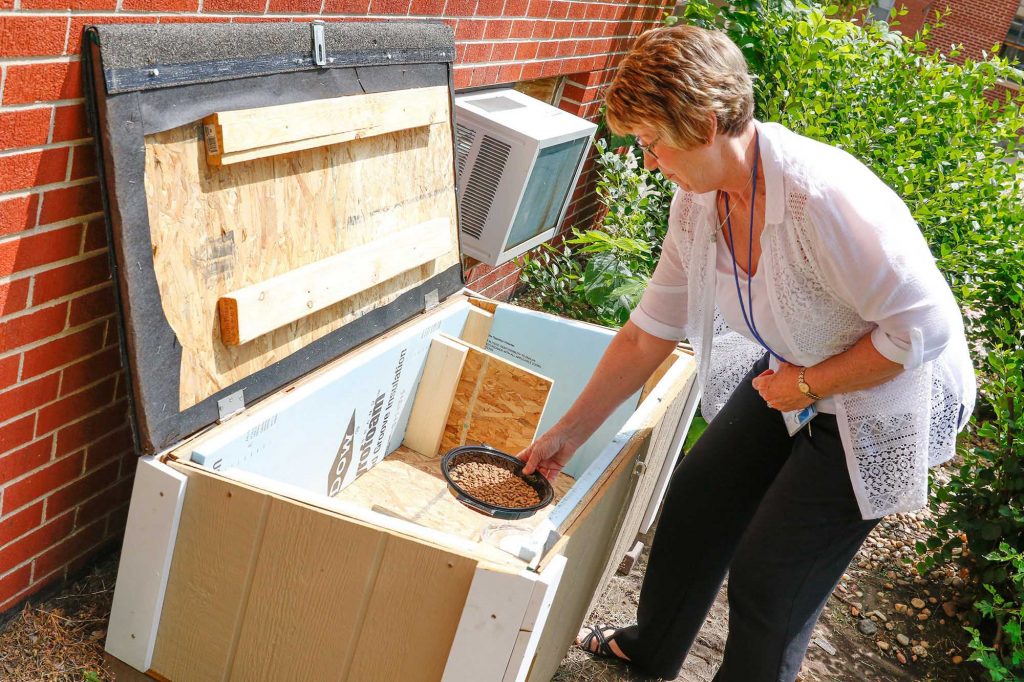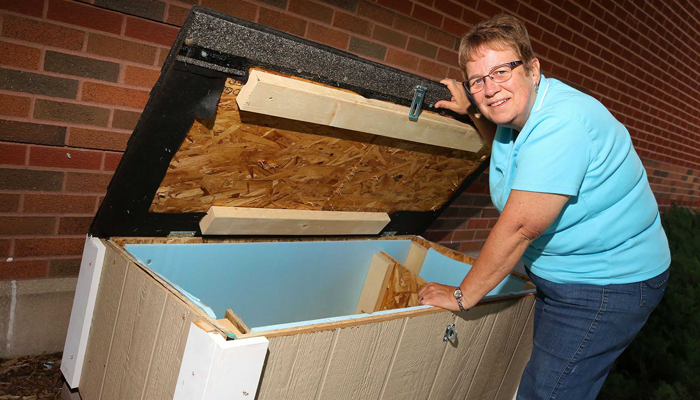
By SARA GIBONEY
UNK Communications
KEARNEY – After nearly 17 years of caring for and feeding feral cats on the University of Nebraska at Kearney campus, a group of cat lovers has enlisted volunteers to build cat feeding stations and raised funds to care for the cats.
Sherry Morrow, assistant professor of industrial technology, began feeding cats on campus and in the community when she noticed that the cats looked hungry. “I can’t stand to see any animal hungry,” she said. “And I was seeing that on campus and around the community.”
Feral cats are typically the result of a domestic cat getting lost or being abandoned. These cats are usually unaccustomed to human interaction and keep a distance from people. Morrow and other faculty and staff set out food and water around campus.
Morrow and others on campus often used a live trap to capture the feral cats, get them neutered or spayed, give them vaccinations, and release them back on campus. Cats that have been neutered or spayed have a notch in one ear.

A few years ago, a group was organized to begin raising funds to buy food and pay for veterinary care for the cats, which had become known as Loper Cats. Morrow and other faculty and staff had been paying to care for the cats out of their own pockets up until then.
The group participates in the Kearney Area Community Foundation’s Give Where You Live fundraising campaign, and they accept donations throughout the year.
Recently, area contractors donated materials, and the UNK Construction Management Organization built eight feral cat feeding stations. Seven stations were placed around campus – at the Fine Arts Building, Calvin T. Ryan Library, Copeland Hall, Conrad Hall, Nebraskan Student Union, Welch Hall and Communications Building. The eighth station is in storage and will be used later, if needed.
“We selected locations around campus where people were feeding the cats,” said Deb Schroeder, assistant vice chancellor of information technology and Loper Cats committee member.
Faculty and staff volunteers replenish food and water in the feeding stations every few days.
“It took the cats a little while to get used to the houses because they were used to eating out of dishes,” Morrow said. “But they’ve warmed up to it and they’re using the houses now to go in and eat and drink.”
Morrow said the cats are an important fixture on campus because they hunt mice and rats, and removing them won’t be effective. “It does no good to remove them because other cats will move in,” Morrow said.
Schroeder added that it’s important not to feed food scraps or handle the feral cats on campus.
No university funds are used to care for the Loper Cats. Donations can be made at the Kearney Area Community Foundation.
For more information, call Sherry Morrow at 308.865.8259.
The University of Nebraska-Lincoln also has a Husker Cats volunteer program, which works to organize veterinary care, foster homes, feeding stations and monetary donations.
-30-
Writer: Sara Giboney, 308.865.8529, giboneys2@unk.edu
Source: Sherry Morrow, 308.865.8259, morrows@unk.edu